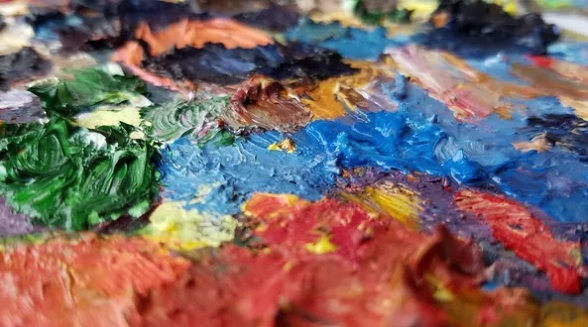Contents
How to Do Abstract Painting
How to make an invisible drawing + checklist – includes ideas and tips, visual examples, video, and a free checklist!
On Instagram, where I shared a lot behind the scenes and processes, someone recently asked me about my ‘secrets’ when it came to how to make an invisible drawing.

First of all, I got that kind of humour because until recently, I hadn’t ‘found’ or enjoyed making invisible art. I firmly attached one foot to the image, even though I was very lost in the fabric.
I took two abstract drawing lessons, and while I loved both, I never thought it was for me.
Second, I suddenly realized that my work had recently become a thing of the past. It started with coastal areas and gradually became more and more fragmented, to the point where I now ‘almost have a few invisible images’ and several completely invisible paintings. I did not choose the wrong one – until I thought I did not like it and could not do it – it just started happening.
Meet Me at a Wildlife Sanctuary
Here is the ‘almost invisible’ I just finished; I still remember the dune drawings I did earlier this year, but I look at an unfamiliar place with unusual and exciting marks.
The question made me think; HOW do you make an invisible drawing? Naturally, that is partly under the watchful eye, but for me, some things make an invisible painting feel very successful.
So I thought I’d share what I suggested to Michele, who asked the question, and add to it a little bit as it might help you.
Use a reference image.
This may sound silly, but having a particular place of origin helps me, especially as someone from a representative background.
I don’t use one all the time, but sometimes I like to have one of my photos to post or something I found on Pinterest {from this board}, so I have a guide to follow based on an existing layout. It works.
It’s usually part of the foundation, and it doesn’t matter what the image’s title is; I usually leave a reference immediately after starting. It just helps to get things going.
Have a Focus
It doesn’t have to be anything, but having a place for the eye to start or end as it wanders the sails helps the painting ‘make sense’ and feel good looking at it. You usually want the focus not on the centre, for the same reason.
In this case, a large white loop at the top works to draw the eye ‘on the road’ in the lower part toward the horizon. It is not the focus of your face but helps the eye movement, which is what the eye wants to do!
Always pay attention to prices.
Although there are abbreviations with a small amount of excellent value, that is not something I have read well. It’s a bit difficult because you have very little to work with, so you need a lot of confidence and practice. {Don’t let that stop you from leaving!}
A limited list of values can make a drawing feel shallow and have nothing meaningful to say. It can also confuse the viewer if there is not enough way for the eye to follow it, but it is hidden.
I like to start with a lot of darkness and gradually remove it. Adding and subtracting is one of the easiest and most forgiving ways to build a drawing because it just keeps going until things start to work together.
Discovery
Here is a solid diagonal diagram with simple numbers in the upper part and dark numbers, ‘concentrating’ at the bottom.
Keep turning it to check the balance.
This is practical advice for any drawing; the more you do it, the easier it is to see what is wrong quickly. Balance does not mean that everything is the same or that it looks the same – that is not pleasing to the eye and strangely often means wrong – it means that all parts of the drawing work together and within the framework of the four edges.
Check your edges!
The edges are as crucial to the success of the painting as they are to the interior. They can help stabilize the drawing, create a fun balance, or suggest continuing ‘off stage’. Keep an eye on them as you paint, and do not let your focus get lost in the middle.
Notice that in this case, a few poles come in from the right, and the left grass disappears along the edge. It wouldn’t look right if I didn’t have something to touch the edges. {Try to block them with your fingers – you’ll see what I mean!}
Change Your Marks
Marks are interesting. They ‘talk’ to each other so that everyone who does it participates in the conversation. It is up to you to create a consistent or unrelated conversation, but ‘readable’ by the viewer, even though no two people will read it in the same way. {Art is full of paradox!}
I like to push myself to make as many types of marks as I can while working; it is surprisingly tricky because we fall into patterns and habits. For example, I have a deep love for and continuous practice of making straight marks, so I have to be careful to measure that with more horizontal than I think I can do. It’s so fun to have that challenge running as I paint – it keeps me standing on my toes!
Here is a test for my recent marks in Touchstone. There is no reference image, but that ‘path’ appears again! And quite a few vertical. 🙂
Use Your Emotions
The title can be pure feelings because invisible art does not have a visible theme. I recently did a painting while drinking wine and dancing, and I was in a perfect mood when I did. {Wine! Limited art offerings!}. Here is the diagram that caused:
It’s a mess, and I’ve been a little quieter, but you can see and feel the excitement I felt when I painted it. So pass on what you hear and let it know your drawing! This can be very cathartic too.
Be Sensible
The thing I have been playing with a lot lately is the idea of drawing ‘weather’. That does not paint the blue sky or the rain, but the feeling of the weather, especially the wind. I’m not sure why – the wind is my favourite weather – but often when I paint, I think about the wind and how it ‘looks’. It helps to keep the drawings solid and alive.
You may choose a less violent idea! No matter what it is, it only encourages you and helps you stay focused. Switching from one concept to another can lead to confusing and confusing drawings.
Could You Keep It Simple {Your Way, Not Drawing?}
As a basic rule of thumb, diversity and comparison will help make a drawing enjoyable, especially if you are a bit noob and don’t feel very confident about what you are doing! I like paintings with a lot of darkness and lights and a sense of dynamic movement.

